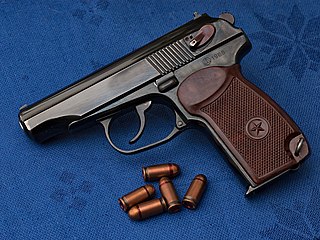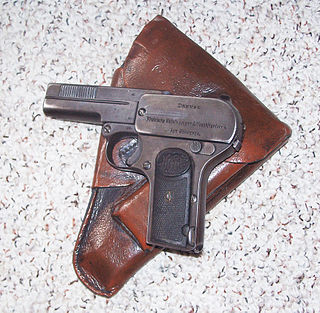
The Browning Hi-Power is a single-action, semi-automatic pistol available in the 9×19mm Parabellum and .40 S&W calibers. It was based on a design by American firearms inventor John Browning, and completed by Dieudonné Saive at FN Herstal. Browning died in 1926, several years before the design was finalized. FN Herstal named it the "High Power" in allusion to the 13-round magazine capacity, almost twice that of other designs at the time, such as the Walther P38 or Colt M1911.

The Mauser C96 is a semi-automatic pistol that was originally produced by German arms manufacturer Mauser from 1896 to 1937. Unlicensed copies of the gun were also manufactured in Spain and China in the first half of the 20th century.

The Makarov pistol or PM is a Soviet semi-automatic pistol. Under the project leadership of Nikolay Fyodorovich Makarov, it became the Soviet Union's standard military and Militsiya side arm in 1951.

The Walther PP series pistols are blowback-operated semi-automatic pistols, developed by the German arms manufacturer Carl Walther GmbH Sportwaffen.

The SIG Sauer P220 is a semi-automatic pistol designed in 1975 by the SIG Arms AG division of Schweizerische Industrie Gesellschaft, and produced by J. P. Sauer & Sohn, in Eckernförde. It is currently manufactured by both SIG Sauer companies: SIG Sauer GMBH, of Eckernförde, Germany; and SIG Sauer, Inc., of New Hampshire, United States.

The Beretta M1951 is a 9×19mm semi-automatic pistol developed during the late 1940s and early 1950s by Pietro Beretta S.p.A. of Italy. The pistol was produced strictly for military use and was introduced into service with the Italian Armed Forces and other Italian security forces as the Modello 1951 (M1951), replacing the Modello 1934 pistol chambered for the 9×17mm Short cartridge.

The Walther P38 is a 9 mm semi-automatic pistol that was developed by Carl Walther GmbH as the service pistol of the Wehrmacht at the beginning of World War II. It was intended to replace the comparatively complex and expensive to produce Luger P08. Moving the production lines to the more easily mass producible P38 once World War II started took longer than expected, leading to the P08 remaining in production until September 1942 and copies remained in service until the end of the war.

The Vz. 50 is a Czechoslovakian made double-action, semi-automatic pistol. Vz is an abbreviation of the Czech term "vzor" meaning model.

The Mauser HSc is a 7.65mm pistol introduced in Nazi Germany during World War II, and manufactured until 1977. The designation HSc stood for Hahn SelbstspannerPistole, third and final design "C". Production was continued in 1945–1946 during the French occupation and, from 1968 to 1977 by Mauser. It has a semi-exposed hammer, double-action trigger, single-column magazine, and a spring surrounding the barrel.

The Colt Delta Elite is a modified series 80 M1911 pistol chambered for the 10mm Auto cartridge. It was first introduced in 1987 by the Colt's Manufacturing Company.

The Steyr M is a series of semi-automatic pistols developed by Steyr Mannlicher GmbH & Co KG of Austria for police services and the civilian shooting market. Design work on the new pistol began in the early 1990s and the final product known as the M9 was officially unveiled in the spring of 1999. The M40 version chambered in .40 S&W was developed before the M9, followed later by the M357 and two smaller variants of the M9 and M40 designated the S9 and S40 respectively. These pistols were developed primarily for concealed carry and have a shortened barrel, slide, smaller frame and a reduced magazine capacity. In 2013, the Steyr M (Medium) and S (Small) form factors were complemented by the L (Large) sized series and the C (Compact) sized series both available in 9×19mm Parabellum and .40 S&W chamberings as the L9-A1, L40-A1, C9-A1 and C40-A1.

Star Bonifacio Echeverria, S.A. was a manufacturer of small arms in the Basque region of Spain from about 1905 until 1997.

The Walther PPS is a semi-automatic pistol developed by the German company Carl Walther GmbH Sportwaffen of Ulm for concealed carry for civilians and plainclothes law enforcement personnel. It is available in either 9×19mm Parabellum or .40 S&W chamberings. It was first shown in 2007 at the IWA & OutdoorClassics and is a slim polymer framed weapon of similar size to the Walther PPK pistol. The PPS is however technically much more based on the Walther P99 pistol.
The Walther Model 1936 Olympia II is a single action semi-automatic handgun manufactured by Walther. The first version was the M1925, formally known as the Automatic Walther Sport Pistol cal. 22 LR, and was introduced in 1925. It was followed by the M1932, the Olympia Pistole I, and used to good effect in the 1932 Olympic Games. The final development Walther made was the M1936 Olympia II that won five gold medals at the 1936 Berlin Olympics and effectively ended the Olympic reign of the Colt Woodsman Target model. The pistol continued to be manufactured up until 1944, but no major changes were made during the war. In 1952 the pistol was reintroduced under license by Hämmerli-Walther. In 1957 Smith & Wesson introduced the Model 41, based on the Olympia-Pistole. The Norinco TT Olympia is a Chinese copy of the Walther M1936 Hunter made sometime after 1980. Most variants were chambered for the .22 Long Rifle but the Schnellfeuer version used the .22 short, produced to equip the German team for the Berlin Olympic Games of 1936 for the rapid fire events. The Olympia pistol is a fixed barrel, internal hammer, open-topped slide design and had a large contoured wooden grip which extended well below the bottom of the butt frame causing the necessity of the magazine bottom plate to be fitted with a wooden block extension. Once World War II started, the need for weapons quickly shifted from competition and sport to the military, thus Olympia production slowed.

Astra Unceta y Cía was a Spanish weapons manufacturer founded on July 17, 1908, under the name Esperanza y Unceta by Juan Esperanza and Pedro Unceta. Initially based in Eibar, the centre of the Basque arms industry, the company moved in 1913 to Guernica.

Glock is a brand of polymer-framed, short recoil-operated, locked-breech semi-automatic pistols designed and produced by Austrian manufacturer Glock Ges.m.b.H.
Llama Firearms, officially known as Llama-Gabilondo y Cia SA, was a Spanish arms company founded in 1904 under the name Gabilondo and Urresti. Its headquarters were in Eibar in the Basque Country, Spain, but they also had workshops during different times in Elgoibar and Vitoria. The company manufactured moderate-priced revolvers and self-chambering pistols in a wide variety of models. These were popular mainly in the European and Latin American export market, as well as domestically in Spain.

The Dreyse Model 1907 is a semi-automatic pistol designed by Louis Schmeisser. The gun was named after Nikolaus von Dreyse, the designer and inventor of the Dreyse Needle Gun. The Waffenfabrik von Dreyse company was acquired by Rheinische Metallwaren & Maschinenfabrik Sömmerda in 1901, although the Dreyse Model pistols were marketed under the Dreyse name.

Manurhin is a trademark used by Chapuis Armes since 1998. It is used to designate the Manurhin MR73 revolver family, manufactured at Saint-Bonnet-le-Château, France.

The Walther Model 8 was a 6.35mm single-action pocket pistol manufactured by Carl Walther CmbH between 1920 and 1940. It was fed by an 8-round magazine and chambered in .25 ACP. The Model 8 is a blowback pistol with a concealed hammer and has several design features that were innovative for Walther, including fewer parts and an easier disassembly.



















